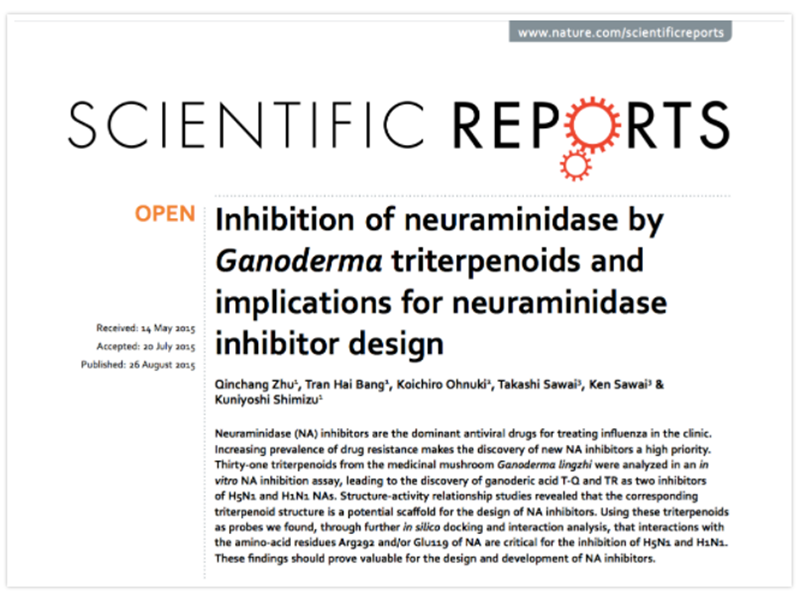أغسطس 26, 2015 / جامعة كيوشو / التقارير العلمية
نص / وو تينغياو

فريق البحث كونيوشي شيميزو, أستاذ مشارك في معهد العلوم الزراعية بجامعة كيوشو في اليابان, أكد ذلك 31 ترايتيربينويدات المعزولة من الجسم الثمري للجانوديرما تمنع النورامينيداز الخاص بخمسة فيروسات من فيروسات الأنفلونزا A بدرجات متفاوتة, من بينها نوعان من ترايتيربينويدات مناسبة للتطوير كأدوية مضادة للأنفلونزا. ونشرت نتائج البحث في مجلة «ساينتفيك ريبورتس» التابعة لمجموعة «نيتشر» للنشر نهاية أغسطس الماضي 2015.
النورامينيداز هو أحد البروتينين البارزين على سطح فيروسات الأنفلونزا A. يحتوي كل فيروس من فيروسات الأنفلونزا على حوالي مائة من هذه البروتيازات. عندما يغزو الفيروس الخلية ويستخدم المادة الموجودة في الخلية لتكرار جزيئات الفيروس الجديدة, هناك حاجة إلى النورامينيداز لجزيئات الفيروس الجديدة للانفصال عن الخلية وإصابة الخلايا الأخرى بشكل أكبر. لذلك, عندما يفقد النورامينيداز نشاطه, سيتم حبس الفيروس الجديد في الخلية ولن يتمكن من الهروب, سيتم تقليل التهديد الذي يتعرض له المضيف, ويمكن السيطرة على المرض. دواء الأوسيلتاميفير الشائع الاستخدام (تاميفلو) في الممارسة السريرية هو استخدام هذا المبدأ لمنع تكاثر الفيروس وانتشاره.
وفقا لبحث أجراه كونيوشي شيميزو, بتركيز 200 ميكرومتر, هذه الجانوديرما ترايتيربينويد تمنع نشاط فيروس H1N1, H5N1, H7N9 واثنين من السلالات المتحولة المقاومة NA (H1N1, N295S) و غير متوفر (H3N2, E119V) بدرجات متفاوتة. على العموم, التأثير المثبط على النورامينيداز من النوع N1 (وخاصة فيروس H5N1) هو الأفضل, والتأثير المثبط للنورامينيداز لفيروس H7N9 هو الأسوأ. ومن بين هذه ترايتيربينويدات, أظهر حمض الجانوديريك TQ وحمض الجانوديريك TR أعلى مستويات التثبيط, وتراوحت تأثيرات هذين المركبين من 55.4% ل 96.5% تثبيط لأنواع فرعية مختلفة NA.
كشف التحليل الإضافي للعلاقة بين البنية والنشاط لهذه التريتيربينويدات أن الترايتيربينويدات, والتي لها تأثير مثبط أفضل على النورامينيداز N1, لها الهيكل الرئيسي "ترايتيربينويدات رباعية الحلقات مع رابطتين مزدوجتين"., فرع كمجموعة الكربوكسيلية, ومجموعة تحتوي على الأكسجين في موقع R5" (العمود الفقري A في الشكل أدناه). إذا كان الهيكل الرئيسي هو الآخران (العمود الفقري B وC في الشكل أدناه), سيكون التأثير ضعيفا.

(المصدر/ممثل العلوم. 2015 أغسطس 26;5:13194.)
يتم استخدام الإرساء السيليكو لمحاكاة تفاعل أحماض الجانوديريك (تي كيو و تر) والنورامينيداز (H1N1 وH5N1). نتيجة ل, وقد وجد أن كلا من أحماض الجانوديريك والتاميفلو كانا قادرين على الارتباط مباشرة بالمنطقة النشطة للنورامينيداز.. تتكون هذه المنطقة النشطة من العديد من بقايا الأحماض الأمينية. سوف ترتبط أحماض الجانوديرما TQ وTR ببقايا الأحماض الأمينية Arg292 وGlu119. لدى عقار تاميفلو خيار آخر ولكنه قد يجعل النورامينيداز غير فعال أيضًا.
بالمقارنة مع تثبيط البروتينات الأخرى على فيروس الأنفلونزا (مثل بروتين M2, الذي يفتح غلاف الفيروس في اللحظة التي يرتبط فيها الفيروس بالخلية المضيفة ويرسل الجينات الفيروسية إلى الخلية), تُعرف مثبطات النورامينيداز حاليًا بأنها أدوية فعالة وأقل مقاومة لعلاج الأنفلونزا. لذلك, يعتقد الباحثون أن أحماض الجانوديريك T-Q و TR, وهي مشابهة ولكنها ليست هي نفسها في آلية تاميفلو, لدينا الفرصة لاستخدامها كجيل جديد من الأدوية المضادة للأنفلونزا أو مراجع التصميم.
لكن, هناك شرط أساسي لاستخدام الدواء كدواء مضاد للأنفلونزا, إنه, يجب أن يمنع الدواء تكاثر الفيروس بشكل فعال دون الإضرار بالخلايا المصابة بالفيروس. لكن, في تجارب على الخلايا المصابة بالفيروسات الحية وخطوط خلايا سرطان الثدي (إم سي إف-7), وقد وجد أنه عندما استخدم الباحثون هذين النوعين من أحماض الجانوديريك وحدهما, كانت لديهم شكوك حول ارتفاع السمية الخلوية, لكنهم وجدوا أيضًا نوعًا آخر من الجانوديرما ترايتيربينويد, جانوديرول ب, له تأثير مثبط على H5N1 (لكن التأثير المثبط ضعيف), ولكنها ليست سامة للخلايا. لذلك, يعتقد الباحثون أن كيفية تحسين سلامة أحماض الجانوديريك T-Q وTR من خلال تعديل التركيب الكيميائي مع الاحتفاظ بتثبيط نشاط النورامينيداز يجب أن تؤخذ بعين الاعتبار بعناية..
[مصدر] تشو ك, وآخرون. تثبيط النيورامينيداز بواسطة غانوديرما ترايتيربينويد والآثار المترتبة على تصميم مثبط النورامينيداز. مندوب العلوم. 2015 أغسطس 26;5:13194. دوي: 10.1038/srep13194.
نهاية
نبذة عن الكاتبة/ م. وو تينغياو
وقد ظل وو تينغ ياو يقدم تقارير عن معلومات الجانوديرما المباشرة منذ ذلك الحين 1999. هي مؤلفة الشفاء بالجانوديرما (نشرت في دار النشر الطبية الشعبية في أبريل 2017).
★ يتم نشر هذه المقالة بموجب التفويض الحصري للمؤلف.
★ لا يمكن إعادة إنتاج الأعمال المذكورة أعلاه, مقتطفة أو مستخدمة بطرق أخرى دون إذن المؤلف.
★ لانتهاكات البيان أعلاه, سوف يتابع المؤلف المسؤوليات القانونية ذات الصلة.
★ تمت كتابة النص الأصلي لهذه المقالة باللغة الصينية بواسطة Wu Tingyao وترجمها إلى الإنجليزية بواسطة Alfred Liu. إذا كان هناك أي اختلاف بين الترجمة (إنجليزي) والأصل (الصينية), يجب أن تسود الصينية الأصلية. إذا كان لدى القراء أي أسئلة, يرجى الاتصال بالمؤلف الأصلي, آنسة. وو تينغياو.



